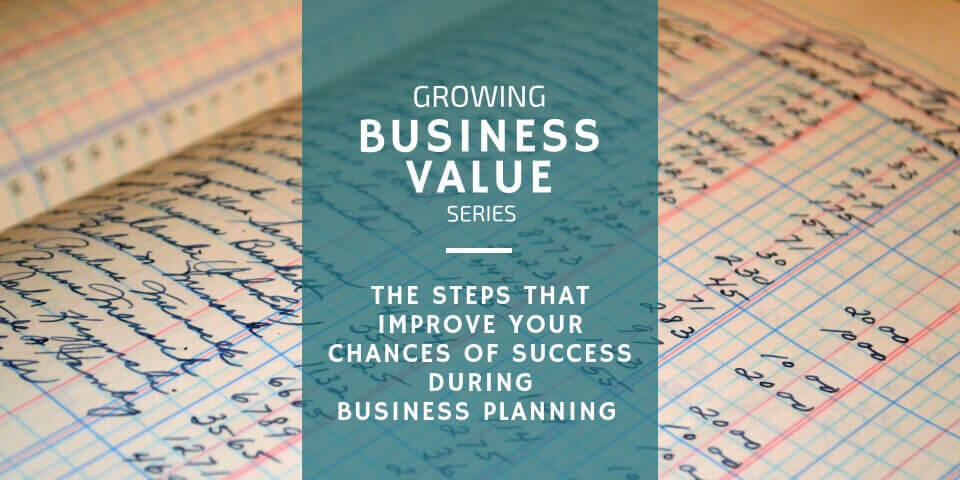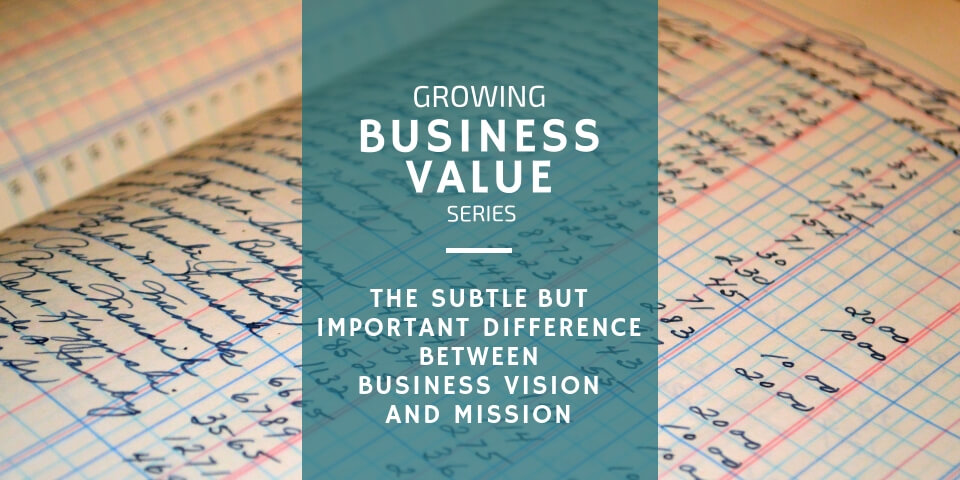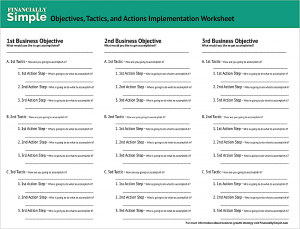
4 Steps to Help Make Your Business Planning Process Successful
November 29, 2018
Understanding The Difference Between Business Vision and Mission
December 5, 2018The Strategic Planning Process: Steps to Clarity and Direction

As a business owner, you’ll do several different types of planning throughout the life of your business. Although all planning methods are important, one type of planning stands apart from the rest. When you’re trying to solve day-to-day issues and increase the intrinsic value of your company, strategic planning is vital to accomplishing your goals. Therefore, I’m going to walk you through how to develop a strategic plan to implement when you’re looking for solutions to problems… and to grow the value of your business.
Follow along with the Financially Simple podcast:
Podcast Time Index for “The Strategic Planning Outline: Long-term Planning for Increased Business Value”
- 00:34 – The Strategic Planning Process Overview
- 01:51 – The Vision: Test & Execution
- 03:09 – Different types of Planning
- 03:31 – Strategic Planning
- 05:39 – The Strategic Planning Process
- 07:28 – Vision & Mission
- 08:41 – Values & SWOT
- 09:32 – Objectives & Strategies
- 10:22 – Tactics
- 10:37 – Actions
- 11:40 – The Who
- 16:29 – The When
- 19:08 – The Where
Sabermetrics – A Strategic Planning “Win”
In 2003, author Michael Lewis introduced sabermetrics, the empirical analysis of baseball and baseball statistics, to the world. In the book Moneyball: The Art of Winning an Unfair Game, Lewis highlights the strategic planning methods Oakland Athletics’ manager, Billy Beane, used to build a powerhouse professional baseball team on a low-cost budget for the 2002 season.
First, Beane cast a vision. He wanted to build a well-rounded, moderately paid baseball team that could compete against richer teams in Major League Baseball. Then, he tested the viability of his vision. He and his management team recruited players based on objective statistics rather than on subjective impressions of players’ skill sets. Next, the recruited players executed and proved the validity of Beane’s vision, working together to become competitive against larger, more affluent teams like the New York Yankees.
The Definition of Strategic Planning
According to Wikipedia, strategic planning is “an organization’s process of defining its strategy, or direction, and making decisions on allocating its resources to pursue this strategy.” To me, strategic planning is the process of making long-term plans for what you want your business to accomplish and taking logical, short-term actions that will help you achieve your long-term goals.
Think about strategic planning this way. When you get in your vehicle each day, you have a destination in mind… you have a long-term travel goal. You know where you want to go, and you’ve mapped out directions to get you to your ultimate destination. Those directions are your short-term strategies to get you to your goal. Many times, though, while you’re driving, you get so focused on the road in front of you or the view around you that you forget where you’re actually going.
That’s where business owners get stuck, too. You get so focused on the next steps needed during day-to-day operations that you forget where you’re trying to go as a business. Yet, as the old saying goes, “if you aim at nothing, you’ll hit it every time.” That’s why strategic planning is so important for business owners. You must know where you’re going AND how to get there. You must make long-term plans and take short-term actions. That’s where the Strategic Planning Framework comes in. It’s all about staying focused.
The Strategic Planning Process
Far too often, business owners chase profits, believing this to be the best method for increasing the value of their business. However, this is a misconception that will leave you exhausted and unfulfilled more often than not. Instead of trying to increase profits, turn your efforts toward your business. By focusing on growing the business, the sellable value of your company will increase in the eyes of customers, investors, and buyers.
There is a framework involved in the strategic planning process that we use in both our business and the other companies we build plans for. It doesn’t matter what type of business you own, the principles are universal. An effective and well-thought-out strategic plan should always go through this process. So what are these steps that are so vital to well-thought-out strategic planning?
The Eight Elements of A Strategic Plan
- Vision – Envision where your company will be in 5 years.
- Mission – Write a mission statement.
- Values – Write out the values of your organization checking them against your personal long-term vision and mission.
- SWOT – Analyze the strengths, weaknesses, opportunities, and threats within your business.
- Objectives – Pick three specific objectives you want to accomplish based on weaknesses revealed in your SWOT. I always make one financial in nature.
- Strategies – Brainstorm strategies that could solve those objectives. Pick the top 3.
- Tactics – Write down 3 ways you plan to reach each of your objectives within a year’s time.
- Actions – Create 3 action steps you will take quarterly that will help you accomplish each of your yearly tactics.
Vision
Simply put, vision is where you would like your business to be within the next five years. Maybe you would like to have best-in-class technologies or, perhaps, you’re looking to broaden your reach and enter into a new market. Whatever your long-term goal may be, write it down and communicate it with your team. I find that if I don’t put my objectives in writing, they don’t get accomplished. Communicating your vision to your team is beneficial in many ways. For one, you will need their help to accomplish the vision. You may also find that involving your team in the strategic planning process helps them to buy-in and increases team morale.
Mission
If you don’t already have a written mission statement, please, take the time to write one. A solid mission statement should be realistic and achievable in its nature. You want people to believe that your company can actually accomplish its mission. It should be clear in its direction and lead to action. The people within your business should understand how to perform and how to interact with your consumer base, based on the mission statement. Finally, it should be motivating. Your team needs to feel that the mission of your company is worthwhile. The vision tells where you are going but the mission statement is your why. That’s why it is so important in your strategic planning process.
RELATED READING: What’s the difference between your company’s Vision and Mission?
Values
Many business owners mistake values for beliefs. Beliefs change with new information. At one time, most of the world believed that the earth was flat. As new evidence and information became available, our beliefs on that matter changed. However, values remain constant. You might value honesty and a strong work ethic. As a result, you are likely to work hard and carry yourself with integrity. The values that you hold dear should be expressed through your business. As such, your vision and mission statements should also align with your core values. I always recommend having a written values statement that you share with your team.
SWOT Analysis
In order to construct an effective strategy to reach your long-term vision, you must understand your business’s strengths, weaknesses, opportunities, and threats. During this step, it’s very important to view your business honestly and objectively. Use this time as an opportunity to grow. You want to capitalize on and protect your organization’s strengths while improving its weaknesses. Likewise, you want to take advantage of opportunities while protecting yourself from threats to your business. The SWOT analysis is one of the most important steps when creating your strategic plan because it provides you with definable targets to achieve your long-term vision.
State Your Objectives
Now that you’ve completed your SWOT analysis and identified your organization’s weaknesses, you need to select three specific objectives based on those weaknesses. When I am working through the strategic planning process, I always make sure that one of my three objectives is financial in nature. The objectives that you set will be your goals for the next three years. Many business owners choose to set their annual objectives according to a theme. For example, you might focus on improving your sales processes and systems for one year and work to enter a new market the next.
Select A Set of Strategies
At this stage, you and your team should have a clear vision that is supported by your mission and values. You should also understand your strengths, weaknesses, opportunities, and threats, and what needs to be done to improve them. Now you need to have a brainstorming session with your team to find strategies that can help you to meet your annual objectives. Selecting the right strategies will help you to reach your goals by providing you with a roadmap, telling you how to get to your destination.
Outline Your Tactics
With your objectives defined and a few strategies selected to guide your team to success, now it’s time to choose three tactics that will drive you toward your three-year objectives. Many business owners choose to set their annual tactics according to a theme. For example, you might focus on improving your sales processes and systems for one year and work to enter a new market the next. Tactics are the tangible directives of your strategies.
Stepping Into Action
Finally, you and your team are ready to put your plan into action. Choose three action steps that will take you through the next quarter. Your action steps should be achievable within a 90-day timeframe and they should be directed toward accomplishing your annual tactics which are directed at accomplishing your objectives that are driving toward your long-term vision. As you can see, there is a lot of work involved in strategic planning and each step in the framework works to achieve the work of the previous step.
Who Should Be in Your Company’s Plan?
If you follow all of the steps in the framework above, you’ll definitely have your hands full. Thus, even if you are the only person working in your company, don’t plan alone. If that’s you, get your advisory team involved. On the other hand, if you own a business with employees and a management structure, everybody in the organization should be involved in your strategic planning at some point.
Ultimately, as a business owner, you want to cast the vision and determine your company’s mission based on your own core values. You should be involved in all 8 aspects of strategic planning. However, getting your whole team involved and hearing insights from your managers and team members (or a business coach if you run the business alone) is vital to accomplishing your strategic planning goals. But why?
Well, if you can get your whole team involved in the strategies, tactics, and actions that must be taken to accomplish your objectives, then you’ll have more buy-in and commitment. If your team members understand your vision and mission, they can help you set objectives. Then, since they are the ones running the day-to-day operations of your business, they’ll be able to help you determine what actions are realistic to take.
When Should You Meet to Plan Your Company’s Strategic Growth?
So if everyone on your team is involved in some aspects of strategic planning, when should you meet? I typically suggest following a 1-4-12-52 model.
The 1 – Annually
First, I meet with my team annually to carry out the steps in the strategic planning framework. I set aside a day or two in July because that’s our slow period. Just pick a time that you can stick to once a year. In this meeting, you’ll share your long-term vision, mission, and values with your team members. Often, this is where you’ll get them to buy-in. Then, as a group, you’ll analyze your company’s strengths, weaknesses, opportunities, and threats to set your 3-year and 1-year objectives, forecasting out what you want to accomplish. Finally, you’ll determine the short-term strategies, tactics, and actions needed to accomplish your long-term objectives.
The 4 – Quarterly
Next, I like to meet with my team to follow-up on my strategic planning objectives quarterly. If you hold similar meetings, you’ll analyze how much you’ve accomplished over the past 3 months. Break your 1-year goal into strategic quarterly pieces. Then, determine whether or not you accomplished what you set out to do within that time frame. Are your strategies working? Are you closer to achieving your goals? If not, revise your strategies and set forth again.
The 12 – Monthly
Not only do I like to meet yearly and quarterly, but I also meet with my team members monthly. If you imitate my meetings, you’ll break your goals into quarterly strategies and into monthly action steps. In these monthly meetings, you and your team members will hold each other accountable. Are you following the strategies that will help you meet your objectives? Do your actions fall in line with your vision, mission, and values? Are they getting you where you want to be? By having your team members hold you accountable, I find that they feel empowered, and their morale goes up. High company morale leads to vision buy-in which leads to a higher chance of reaching your company’s objectives.
The 52 – Weekly
Finally, I like to meet with my team weekly. If you hold weekly meetings, you can determine what each member must accomplish that week to meet your quarterly and yearly company goals. With these weekly meetings, you can keep everyone engaged and reminded of the long-term objectives. Essentially, you should approach this process in the same way you would eat an elephant, one bite at a time.
Executing your strategic plans matters. By meeting on a yearly, quarterly, monthly, and weekly schedule, you can keep your entire team on track to meet your long-term goals.
For an in-depth discussion about the Timing Methodology of Strategic Planning Meetings, listen to our Podcast.
Next Steps
The process of developing a strategic business plan is tough, friends. It can be frustrating and tedious. Yet, if you want to increase the intrinsic value of your company, you must make strategic plans. Sure, you can increase your top-line revenue without planning. You can even decrease expenses on your own. However, if you want to increase the qualitative parts of your business, you will most likely fail without making plans. Proper strategic planning isn’t a microwave dinner, it’s a crock-pot recipe that is slow and methodical. In the end, it yields quality results.
The process of planning, creating action steps, and executing them, will prepare your company to meet its goals and objectives. It will determine your company’s destination and the steps you must take to reach that destination. Ultimately, strategic planning will help you increase the value of your company because it helps you cast a vision and take the steps necessary to make that vision happen.
Is your business experiencing problems? Solutions come when you have a plan! Download our free Strategic Planning Worksheet to begin improving your business today. If you’d like a little more professional guidance, reach out to us. The team at Financially Simple is happy to help!




